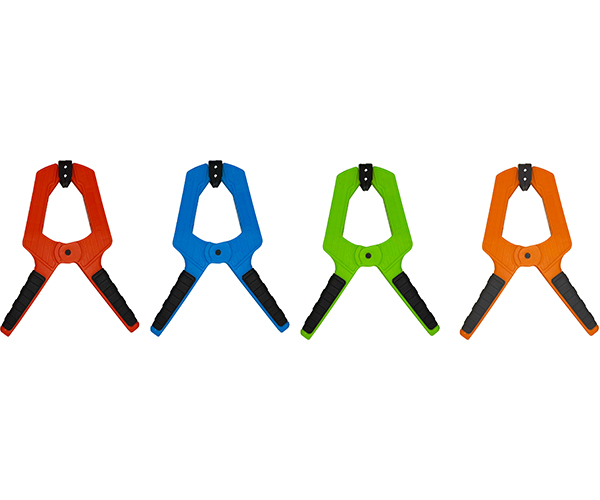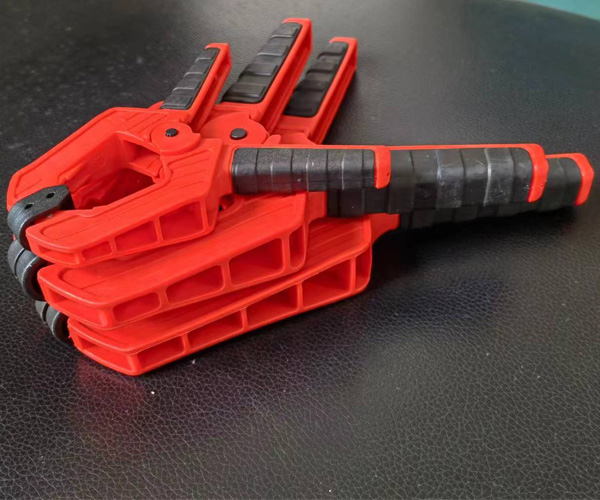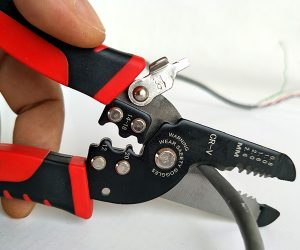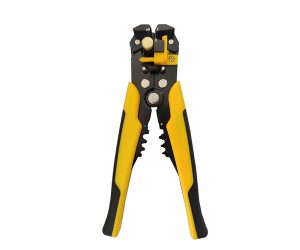A spring clamp is an essential tool that plays a critical role in a variety of industries, including automotive, woodworking, and DIY projects. These simple yet effective tools use a spring mechanism to apply pressure, holding materials firmly in place. Spring clamps come in a range of sizes and designs, making them suitable for numerous tasks. In this article, we will explore the definition of a spring clamp, its uses, and how it compares to other types of clamps. You’ll also learn about its importance in various applications and how to choose the right one for your needs.
1. What is a Spring Clamp?
Spring clamps are versatile tools designed to temporarily hold materials together. They are particularly useful for projects that require a quick, adjustable hold without the need for additional fasteners. But here’s the kicker: the design of a spring clamp is simple but highly effective. The clamp typically consists of two arms, each with a rubberized tip to prevent damage to the work surface, and a spring mechanism that applies clamping force when squeezed.
The primary function of a spring clamp is to hold materials in place while you work on them. This makes them ideal for light-duty tasks, where you need temporary stability. Spring clamps are particularly favored for their ease of use and ability to be quickly attached and removed. In contrast to traditional C-clamps, spring clamps don’t require a tightening mechanism, making them quicker and easier to use.
But how do they actually work? The spring mechanism creates constant pressure, ensuring that the two arms stay closed and securely clamp the object. The tension in the spring can vary, allowing for a more adjustable grip depending on the strength needed.
2. What are the Types of Spring Clamps?
There are several types of spring clamps available, each suited to different tasks. Some are designed for specific materials or applications, while others provide a more general-purpose solution. Ready for the good part? Let’s dive into the different types of spring clamps and what makes each one unique.
One common type is the mini spring clamp, which is great for small projects like model making or holding light materials in place. These clamps typically feature smaller jaws and lighter springs, making them easy to handle and perfect for delicate tasks. On the other hand, heavy-duty spring clamps are larger and stronger, designed to handle more demanding tasks such as clamping thick pieces of wood or metal.
There are also specialty spring clamps, which are designed for specific applications. For example, there are spring clamps with cushioned or padded tips to prevent damage to the work surface. These are commonly used in automotive repairs or delicate woodworking projects where the material being clamped must remain undamaged.
What’s the real story with these specialty clamps? They offer additional features that enhance performance, such as enhanced grip strength or protection against scratches. They might cost a bit more, but their durability and specialized functions can make a significant difference in your projects.
3. How Do Spring Clamps Differ from Other Clamps?
Spring clamps have unique features that set them apart from other types of clamps, such as C-clamps or bar clamps. But here’s where it gets interesting: while spring clamps excel at holding materials temporarily, other types of clamps offer additional benefits depending on the task at hand.
C-clamps, for instance, are great for tasks that require a more secure, permanent hold. They are often used in woodworking, metalworking, or automotive work. C-clamps allow for precise adjustments in pressure, which is useful when you need to apply constant pressure over a longer period of time. However, unlike spring clamps, C-clamps can be slow to use and require more effort to position and adjust.
Another comparison is bar clamps, which use a sliding mechanism to adjust the jaw width, allowing them to accommodate larger workpieces. Bar clamps are especially useful in woodworking when you need to clamp large panels or frames. However, unlike spring clamps, bar clamps tend to be bulkier and less portable.
What’s the takeaway here? While spring clamps are great for quick and temporary holds, other types of clamps like C-clamps and bar clamps are better suited for more permanent, heavy-duty tasks. Understanding these differences helps you choose the right clamp for the job, saving time and improving efficiency.

4. What Are the Uses of a Spring Clamp?
Spring clamps are used in a variety of applications, both in professional industries and DIY projects. Let’s take a closer look at where these tools shine. The beauty of spring clamps lies in their versatility and ease of use. They are commonly used in woodworking to hold pieces of wood together while glue dries. For instance, if you’re constructing a picture frame or assembling furniture, spring clamps can hold the pieces in place as you work, allowing you to focus on the next step without worrying about stability.
In automotive repairs, spring clamps come in handy for holding hoses, wires, or other small parts in place while you work. The ability to quickly clamp and un-clamp makes them a go-to tool for anyone working on a car. And let’s not forget their use in DIY projects, where they’re perfect for tasks like holding fabric in place while you sew or securing paper during a craft project.
What about in the industrial world? Spring clamps also have their place in heavy-duty environments. They are used in construction to temporarily hold materials together while other fasteners are installed. Their ease of use and quick application make them invaluable when time is of the essence.
5. Why Are Spring Clamps Important for DIY Projects?
Spring clamps are crucial tools for anyone tackling DIY projects. They offer several benefits, including efficiency, ease of use, and affordability. The beauty of spring clamps lies in their ability to hold materials together without the need for screws or bolts, which can be time-consuming to use and remove. This makes them particularly popular among DIY enthusiasts who need to complete projects quickly and with minimal fuss.
Ready for the good part? One of the key benefits of using spring clamps is that they allow for hands-free operation. For instance, when building a small shelf or assembling a craft project, you can clamp the materials in place and move on to the next step without worrying about the pieces shifting. This gives you more time to focus on the task at hand.
Additionally, spring clamps are an affordable solution for DIYers on a budget. Unlike other types of clamps, which can be expensive and bulky, spring clamps are lightweight, inexpensive, and easy to store. They’re also highly portable, making them ideal for anyone who needs to move around their work area.
6. What Should You Look for When Choosing a Spring Clamp?
When choosing a spring clamp for your project, there are several factors to consider. The most important one is the size of the clamp. But here’s the kicker: choosing the right size ensures that the clamp will fit the materials you’re working with and provide the appropriate level of clamping force.
You also need to consider the strength of the spring. A stronger spring will offer a firmer grip, making it better for heavier materials. If you’re working with lightweight materials or delicate surfaces, however, you may want a spring clamp with a lighter spring to avoid damaging your project.
Additionally, think about the clamp’s jaw opening. Some spring clamps have a wide jaw opening, which allows them to accommodate larger materials. Others may have a narrower opening, which is better for smaller, more precise tasks. What’s the real story here? Choosing the right spring clamp is all about ensuring that the clamp is suited to your specific needs, making your projects easier and more efficient.
7. How Do You Properly Use a Spring Clamp?
Using a spring clamp is simple, but there are a few tips that can help you maximize its effectiveness. The first step is to make sure the clamp is clean and in good working condition. A dirty or rusty spring clamp can lose its grip and may not work as effectively.
What’s the real story with this? Always make sure that the rubber tips of the clamp are in contact with the material you’re clamping. This will help distribute the clamping force evenly and prevent damage to the surface.
When clamping, open the clamp by squeezing the handles together, then position it over the material. Release the handles, and the clamp will automatically close. Ensure that the material is held tightly, but be careful not to over-tighten, as this can cause damage.
8. How Do You Maintain and Care for Your Spring Clamps?
Taking proper care of your spring clamps ensures that they last longer and continue to perform at their best. Luckily, maintaining them doesn’t require much effort. Regular cleaning and proper storage go a long way in extending their lifespan.
To keep your spring clamps in good working condition, start by cleaning them after each use. Dirt, rust, and grease can accumulate over time, reducing the clamp’s performance. Use a soft cloth to wipe down the clamp, and for more stubborn dirt, you can use a mild detergent and water to clean it. For the metal parts, applying a light coating of oil or lubricant can prevent rust and ensure smooth operation.
When storing your spring clamps, keep them in a dry place to avoid rusting. If the clamps are exposed to moisture, consider storing them in a toolbox or storage case that prevents them from getting wet. Proper storage not only prevents corrosion but also keeps your tools organized and easy to find when you need them.
9. Are There Any Safety Concerns with Using Spring Clamps?
While spring clamps are generally safe to use, there are some safety precautions you should take to avoid accidents. Since spring clamps use a spring mechanism to create pressure, it’s important to handle them with care to prevent them from snapping back.
First and foremost, always ensure that your fingers are clear of the clamp’s opening before you release it. If your fingers get caught in the clamp, it could cause injury. Be mindful of how the clamp is positioned on the material, and make sure it’s securely holding the workpiece before you start working.
Additionally, it’s a good idea to wear protective gloves if you’re using spring clamps in high-pressure applications or with materials that could damage your hands. For extra safety, consider wearing safety goggles when working with tools and materials that could cause debris to fly.
10. What Materials Can Spring Clamps Be Used On?
Spring clamps can be used on a variety of materials, but some materials are more suited to spring clamp use than others. Spring clamps are best for lighter materials like wood, plastic, and thin metal, as they provide the perfect balance between clamping force and ease of use.
For delicate materials such as fabrics or papers, look for spring clamps with padded or non-marking tips. These types of clamps will hold the material securely without causing damage. On the other hand, spring clamps can also handle heavy-duty materials like thick wood or larger metal parts, as long as the clamp has enough strength to handle the job.
When using a spring clamp on a sensitive surface, always check the pressure before applying it. For example, if you’re working with glass or soft woods, the clamp might leave an imprint if too much pressure is applied. Adjusting the clamp’s tension is key to avoiding damage while still holding the material firmly.
11. How Strong Are Spring Clamps?
The strength of a spring clamp depends on several factors, including the size of the clamp, the material it’s made from, and the tension in the spring. Larger, heavy-duty clamps typically have stronger springs, which provide more holding force. Smaller spring clamps, on the other hand, offer less force but are still effective for lighter tasks.
How do you know if the clamp has enough strength for your project? A simple test is to try clamping a piece of material and checking how firmly it stays in place. If the clamp doesn’t provide a secure hold, it might be too small or weak for the task. To avoid this issue, always choose a clamp with the appropriate strength for your project. For heavy-duty tasks, such as woodworking or construction, opt for clamps with a higher clamping force.
12. What Are the Alternatives to Spring Clamps?
While spring clamps are versatile and easy to use, there are times when other types of clamps may be a better choice. For example, C-clamps are often used when a tighter, more secure hold is needed, especially for heavy-duty tasks. These clamps provide more pressure and are better for long-term holds.
Bar clamps are another alternative that works well for larger projects. They use a sliding mechanism to increase the width between the arms, allowing you to clamp larger materials, like wide panels or frames. However, unlike spring clamps, bar clamps take longer to adjust and set up.
When deciding which type of clamp to use, consider the size and weight of the materials you’re working with, as well as how long you need the hold to last. For quick, temporary holds, spring clamps are ideal, but for more substantial, permanent clamping, alternatives like C-clamps or bar clamps may be more appropriate.
13. How Do Spring Clamps Help in Professional Applications?
Spring clamps are invaluable tools in professional environments, including automotive repairs, manufacturing, and construction. In the automotive industry, for example, spring clamps are used to hold small parts or wires in place while workers perform repairs. The clamp’s quick-release feature makes it easy for workers to handle and reposition materials without wasting time.
In construction, spring clamps are often used to temporarily hold materials together while more permanent fasteners are installed. The speed and ease of use make spring clamps particularly useful in situations where workers need to move quickly and efficiently.
In manufacturing, spring clamps can be used to hold components together during assembly, improving the precision and speed of the production process. Their small size and portability make them perfect for both small-scale and large-scale operations.

14. What are the Benefits of Using Spring Clamps for Prototyping and Experimentation?
For those involved in prototyping or experimentation, spring clamps provide a quick and reliable way to hold components in place while testing designs or making adjustments. Whether you’re testing a prototype in a workshop or experimenting with a new design in a lab, spring clamps can hold materials securely, allowing you to focus on the task at hand.
Spring clamps are also useful for temporary setups, allowing you to adjust the position of materials quickly without worrying about alignment issues. They help create a stable work surface, which is essential for testing the integrity and functionality of prototypes.
By using spring clamps, you ensure that your prototype stays in place during tests, reducing the risk of errors and improving the accuracy of results. Additionally, their ease of use makes them ideal for rapid iteration, allowing you to test multiple designs or concepts efficiently.
15. How Do Spring Clamps Contribute to Precision and Accuracy in Work?
Spring clamps contribute to precision and accuracy by keeping materials steady and stable during work. This is especially crucial in tasks like carpentry, metalworking, and other projects where alignment is key. The constant clamping force provided by the spring ensures that the materials do not shift or move, which helps maintain accuracy throughout the process.
For instance, when gluing pieces of wood together, using a spring clamp ensures that the pieces remain aligned while the glue dries. Similarly, in metalworking, spring clamps can hold metal parts securely, allowing the worker to focus on the task without worrying about misalignment.
Overall, spring clamps help ensure that materials stay in place, allowing workers to complete their projects with greater precision and fewer mistakes.
FAQ
Q1: What is a spring clamp?
A spring clamp is a tool that uses a spring mechanism to apply pressure, holding materials in place temporarily. It is ideal for tasks requiring a quick and adjustable hold.
Q2: How does a spring clamp work?
A spring clamp works by using a spring to create constant pressure, keeping the two arms closed and securing the material being clamped.
Q3: What are the different types of spring clamps?
Spring clamps come in various sizes and designs, including mini clamps, heavy-duty clamps, and specialty clamps designed for specific applications like automotive repairs or delicate work.
Q4: How do spring clamps compare to other types of clamps?
Spring clamps are great for temporary holds, while C-clamps and bar clamps are better suited for permanent, heavy-duty tasks where precise pressure is needed.
Q5: How do I choose the right spring clamp for my project?
Consider the size, strength, and jaw opening of the clamp. Choose a clamp that fits your materials and provides the right level of clamping force for the task at hand.





